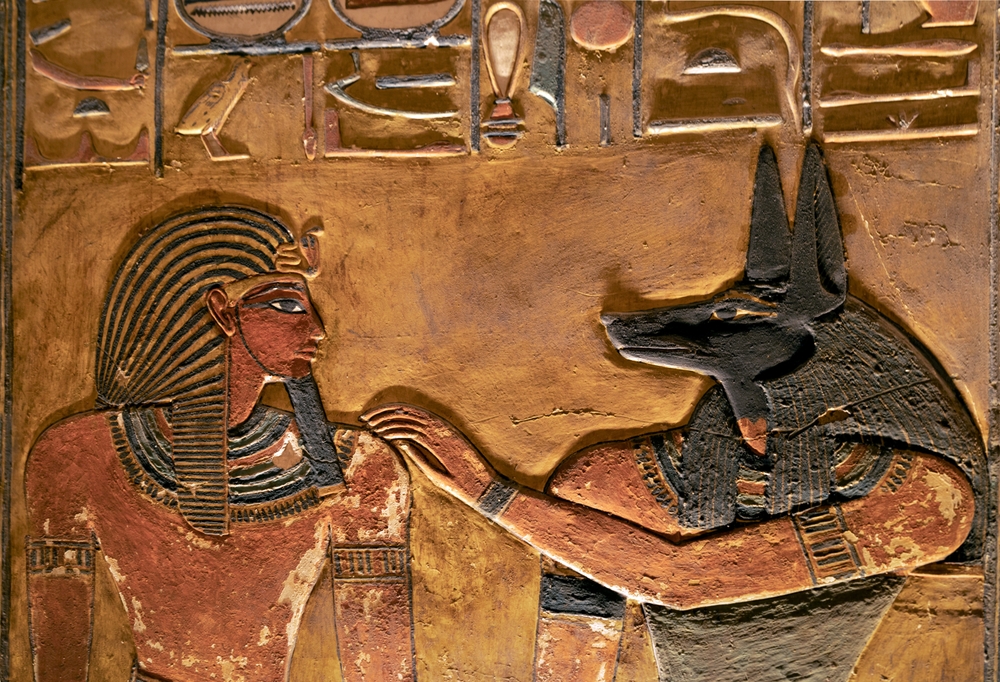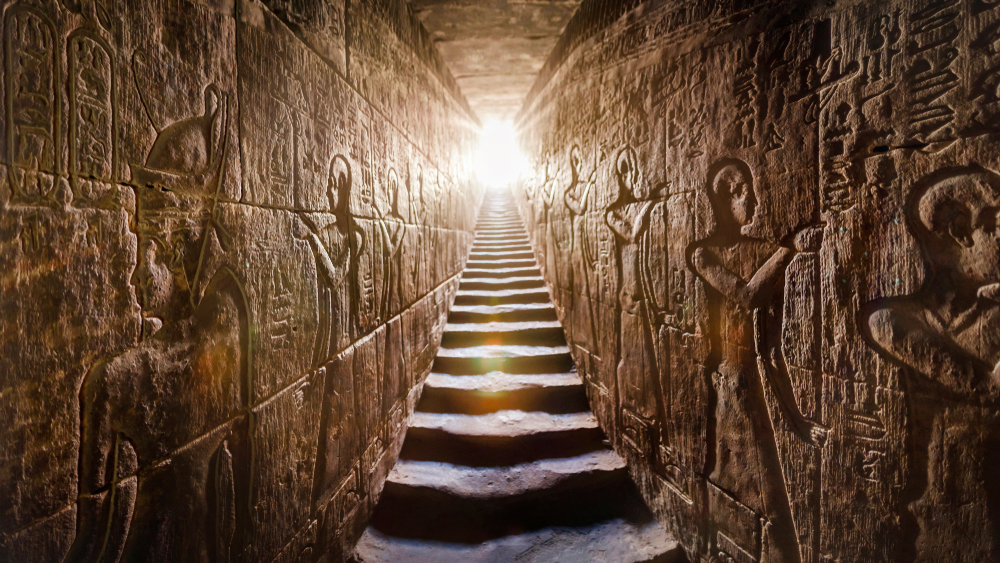If you're fascinated by ancient Egyptian mythology, you've likely come across Anubis, the enigmatic god with the head of a jackal. This powerful Egyptian god played an important role in the beliefs and rituals surrounding death and the afterlife in ancient Egypt. But what makes Anubis so intriguing? Let's delve into the myths, symbols, and powers associated with this fascinating figure.
Jump to:
Who is Anubis?
Anubis, also known as Anpu, is one of the most recognisable deities in Egyptian mythology. Often depicted with the body of a man and the head of a jackal, he is the god of mummification and the afterlife. His striking appearance and significant role make him a key figure in the pantheon of Egyptian gods.
Recommended for you!
Best SellersWhat Was Anubis the God of?
Anubis is the god of mummification and the afterlife. He presides over the embalming process and the rituals associated with the dead. Anubis ensures that the deceased are properly prepared for their journey to the afterlife, safeguarding their bodies and souls.
Anubis' Story and Origins

The story of Anubis is deeply rooted in ancient Egyptian lore. He is the son of Osiris, the god of the afterlife, and Nephthys, the goddess of mourning. However, some myths suggest that his mother is Isis, the goddess of magic and healing. Anubis' association with death and the afterlife began with his role in the mummification process, where he was believed to protect the deceased and guide their souls to the afterlife.
Symbols Associated with Anubis
Anubis is rich in symbolism, each aspect of his appearance and attributes telling a deeper story about his powers and responsibilities:
The Jackal
Anubis is often depicted with the head of a jackal, an animal associated with cemeteries and death. The ancient Egyptians observed jackals prowling around graves, which likely inspired this connection. The jackal's presence symbolised Anubis' role as a protector of the dead.
The Ankh and the Flail
Anubis is sometimes shown holding an ankh, the symbol of life, and a flail, representing his authority. These symbols reinforce his power over life and death and his role in guiding souls to the afterlife.
The Colour Black
Anubis is typically portrayed with black skin, symbolising the colour of mummified flesh and the fertile soil of the Nile, both of which represent regeneration and rebirth. This colour choice highlights Anubis' connection to the afterlife and his ability to guide souls through death to a new existence.
Myths and Legends
The myths and legends surrounding Anubis offer a glimpse into his essential role in the afterlife and his interactions with other deities. These stories highlight his importance in ancient Egyptian culture and religion.
The Weighing of the Heart
One of Anubis' most important roles was in the "Weighing of the Heart" ceremony. In this ritual, the heart of the deceased was weighed against the feather of Ma'at, the goddess of truth and justice. Anubis would oversee this process, ensuring that the scales were balanced correctly. If the heart was lighter than the feather, the soul could proceed to the afterlife. If not, it would be devoured by Ammit, a fearsome creature with a crocodile head, lion body, and hippo hindquarters.
Anubis and Osiris
Anubis played a key role in the myth of Osiris. According to legend, Osiris was murdered by his brother Seth, who dismembered his body and scattered the pieces across Egypt. Anubis helped Isis, Osiris' wife, to find and reassemble Osiris' body, allowing him to be resurrected and become the ruler of the underworld.
The Curse of Anubis
There are various legends about the "Curse of Anubis." One such tale involves grave robbers who disturb a tomb guarded by Anubis. According to the legend, those who disrespect the dead and their resting places are cursed by Anubis, facing severe consequences for their actions.
The Birth of Anubis
A lesser-known myth explains the birth of Anubis. It is said that Anubis was born from the union of Nephthys and Osiris, but Nephthys, fearing the wrath of her husband Seth, abandoned the baby in the wilderness. Isis, the wife of Osiris, discovered the child and raised him as her own. This story underscores the complex relationships among the Egyptian gods and highlights Anubis' divine heritage and protection.
Anubis' Relationships and Family Tree
Understanding Anubis' relationships and family connections provides a deeper insight into his role and significance within Egyptian mythology. Here's a look at his lineage and interactions with other deities.
- Parents: Anubis is commonly believed to be the son of Osiris, the god of the afterlife, and Nephthys, the goddess of mourning. Some myths suggest his mother is Isis, the goddess of magic and healing, who raised him as her own.
- Siblings: In some versions of the myth, Anubis is considered a sibling to Horus, the sky god and protector of the pharaoh, due to the relationship between Osiris and Nephthys.
- Wife: Anubis is said to have a wife named Anput, who shares his jackal-headed appearance and is also associated with funerary rites and protection of the dead.
- Daughter: Anubis and Anput are believed to have a daughter named Kebechet, a goddess associated with purification and the embalming process.
- Connection with Osiris: Anubis played a key role in Osiris's resurrection, helping Isis reassemble and embalm Osiris' body, allowing him to become the ruler of the underworld.
- Association with Nephthys: Nephthys, Anubis' mother, often worked alongside him in funerary practices, emphasising their joint role in protecting and guiding the dead.
- Enemies: As a protector of the dead, Anubis is often seen in opposition to Seth, the god of chaos and disorder, who threatens the balance of the afterlife.
Anubis' Powers

Anubis' powers highlight his significant role in ensuring a safe and just passage for souls through the underworld:
Protection
Anubis is a powerful protector of the dead. He ensures that the deceased are safe from harm and their bodies are preserved for the journey to the afterlife. His role as a guardian highlights his importance in the funerary rites of ancient Egypt.
Guidance
Anubis guides souls to the afterlife, helping them navigate the treacherous journey through the underworld. He ensures that they reach the Hall of Ma'at, where their hearts are weighed and judged.
Judgement
In the "Weighing of the Heart" ceremony, Anubis' presence guarantees that the judgement is fair and just. He ensures that the scales are balanced and that the outcome reflects the true nature of the deceased's heart.
Anubis' Worship and Temples

Anubis was a prominent figure in ancient Egyptian worship, revered for his role as the guardian of the dead and the overseer of mummification. His worship dates back to the earliest periods of Egyptian history, and he maintained a significant place in the religious practices throughout various dynasties.
Temples dedicated to Anubis were often located near necropolises, reinforcing his association with burial sites and the protection of the deceased. One of the most notable temples dedicated to Anubis was in the ancient city of Cynopolis, which means "City of the Dog," highlighting his strong connection to the canine form. Within these temples, priests performed rituals to invoke Anubis' protection for the dead, ensuring safe passage to the afterlife. Statues and images of Anubis, often depicted with a jackal's head, adorned these sacred spaces, symbolising his vigilant watch over the deceased.
The worship of Anubis was not confined to grand temples; smaller shrines and statues could be found in individual tombs, where families would leave offerings to seek his favour and protection for their loved ones in the afterlife.
Interesting Facts about Anubis
- Anubis' Wife and Love Interest: In some myths, Anubis is said to have a wife named Anput, who shares his jackal-headed appearance. Anput is also associated with funerary rites and the protection of the dead.
- Anubis' Sacred Animal: The jackal is Anubis' sacred animal, symbolising his connection to death and the afterlife. This animal's association with cemeteries in ancient Egypt further cements Anubis' role as a guardian of the dead.
- Anubis' Temples and Statues: Several temples and statues were dedicated to Anubis throughout Egypt. One of the most famous statues of Anubis is the black granite statue found in the tomb of Tutankhamun. This statue depicts Anubis in his traditional form, guarding the tomb and ensuring the safety of the pharaoh's journey to the afterlife.
Recommended for you!
Best SellersFrequently Asked Questions about Anubis
Is Anubis a Male or Female?
Anubis is traditionally depicted as a male deity. He is represented with the body of a man and the head of a jackal, fulfilling roles predominantly associated with male gods in Egyptian mythology.
What Breed of Dog is Anubis?
Anubis is often associated with the jackal, an animal native to Egypt and commonly seen around burial sites. While not a specific breed of dog, the jackal is a wild canine that symbolises Anubis' connection to death and the afterlife.
Why Was Anubis Black?
Anubis is typically portrayed with black skin, which symbolises the colour of mummified flesh and the fertile soil of the Nile. This colour represents regeneration, rebirth, and his connection to the afterlife.
What Powers Did Anubis Have?
Anubis possessed several significant powers, including protection of the dead, guiding souls to the afterlife, and overseeing the judgement process in the "Weighing of the Heart" ceremony. These powers made him a crucial figure in ensuring a safe and just passage for souls through the underworld.
Did Anubis Have a Wife?
In some myths, Anubis is said to have a wife named Anput, who shares his jackal-headed appearance. Anput is also associated with funerary rites and the protection of the dead.
What is the Symbol that Anubis Holds?
Anubis is often depicted holding an ankh, the symbol of life, and a flail, representing his authority. These symbols reinforce his power over life and death and his role in guiding souls to the afterlife.
What is Unique about Anubis?
Anubis is unique for his role as the god of mummification and the afterlife, his distinctive jackal-headed appearance, and his involvement in the "Weighing of the Heart" ceremony. His combination of protective and guiding powers makes him a central figure in Egyptian funerary practices.
Who Killed Anubis?
Anubis was not killed in Egyptian mythology. He is an immortal god who continues to perform his duties in the afterlife.
Is Anubis Good or Bad?
Anubis is not inherently good or bad. He is a protector and guide for the dead, ensuring their safe passage to the afterlife. His role is vital in maintaining the balance between life and death.
Study Egyptian Mythology for 29
If you're captivated by the stories of Anubis and the many stories in Egyptian mythology, why not delve deeper? At Centre of Excellence, we offer a fascinating Egyptian Mythology Diploma Course. This course provides an in-depth exploration of the gods, myths, and symbols of ancient Egypt. For a limited time, you can access this course for just £29.













